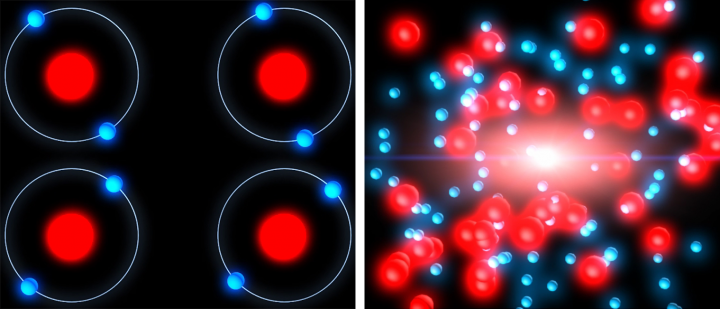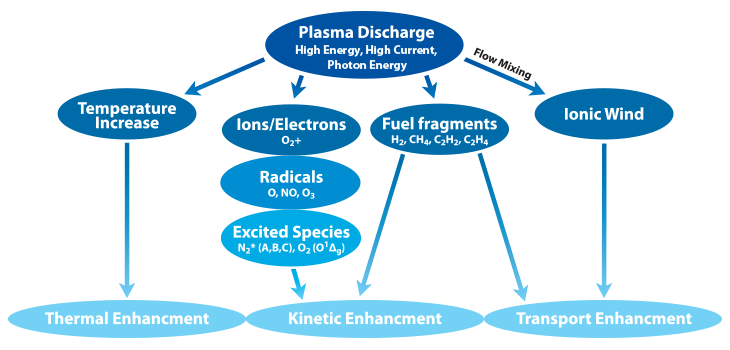Plasma-Assisted Combustion
Liquid, solid and gas are the three well known states of matter; by
subjecting gas to a large amount of electrical energy the fourth state, plasma,
is formed.
About Plasma
Gas has a positive core with negative electrons orbiting around the core. A
plasma is a gas that is heated to the point that the individual gas atoms break
apart to make a collection of positively and negatively charged particles.Plasma-assisted combustion is a relatively new area of study. According to
the American Physical Society, “Scientists know that by introducing plasma to
the reaction – near or at the location where the flame ignites – new chemical
species are produced that catalyze combustion.” Recent studies have shown that
highly reactive plasma can be formed by subjecting the gas in an internal
combustion engine to large amounts of electrical energy within nanosecond
timeframes. Plasma is highly reactive, igniting immediately and combusting
rapidly. Large amounts of the remaining gaseous fuel can also be ignited
instantly by the large ball of burning plasma-affected fuel. Understanding how
to create plasma in an engine and how exactly does it benefit the ignition and
combustion process are major topics in the automotive and natural gas
industries.

For instance, this diagram shows gas atoms with a positive core and orbiting
negative electrons. To form plasma, these gas atoms are subjected to a large
amount of energy and broken apart to form a collection of positively and
negatively charged highly reactive particles. Plasma consists of positively
charged ions with most or all of their detached electrons moving freely about
in a very active manner; these electrons react with other atoms.
Pulstar stores energy accumulated over a relatively long period of time in
its internal capacitor and releases it entirely in less than three nanoseconds.
This massive dump of energy happens so quickly that the pulse it forms is equal
to 5 megawatts. This 5 MW pulse interacts with the gaseous air-fuel mixture,
breaking its molecules apart. This is known as ionization, the process by which
an atom or molecule acquires a negative or positive charge by gaining or losing
electrons to form ions. By ionizing the gaseous air-fuel mixture, Pulstar
breaks down natural elements like H2 and O2 into their
atomic state of H and O where they are most volatile. Thus, the portion of the
air-fuel mixture affected by the pulse has been turned into plasma.
Plasma created by the high-intensity pulse of energy results in three major
benefits in fuel combustion: instant ignition and a quicker and more complete
burn.
Instant Ignition
Temperature Increase. The high-intensity pulse creates a
flash of heat that helps the fuel charge reach the required light-off
temperature to ignite the air-fuel mixture. The flash point for gasoline is
about 600oF and 1,100oF for natural gas. The heat
provided by the plasma, gives the air-fuel mixture a head start to achieving
the temperature required to ignite.
Volatile Air-fuel Mixture. The high-intensity pulse ionizes
the gaseous air-fuel mixture, breaking down air-fuel components like
H2 and O2 into their atomic state of H and O where they
are most volatile. These highly excited elements along with radicals react to
the ensuing spark by igniting instantly.
Quicker Burn
Fuel Fragments. The high-intensity pulse breaks apart the
long hydrocarbon chains found in the nearby air-fuel mixture into shorter
chains that react quickly. This area of the air-fuel mixture burns faster.
Complete Burn
Fuel Fragments. The portion of the fuel that contains
shortened hydrocarbon chains burns faster, and creates a larger surface area to
ignite the rest of the gaseous air-fuel mixture. This allows the air-fuel
mixture to burn more completely during the power stroke.
Ionic Wind. The high-intensity pulse knocks off electrons
from the air-fuel mixture molecules. These ions are thrown out of orbit and
knock off additional ions from neighboring molecules, creating a cascading
effect. This process helps expand the formation of plasma beyond the
high-intensity pulse’s immediate vicinity. As previously mentioned, this plasma
field burns at an accelerated rate.

SUN Wentng and JU Yiguang, (Princeton) J. Plasma Fusion Research Vol 89, No 4 (2013)

 0
0